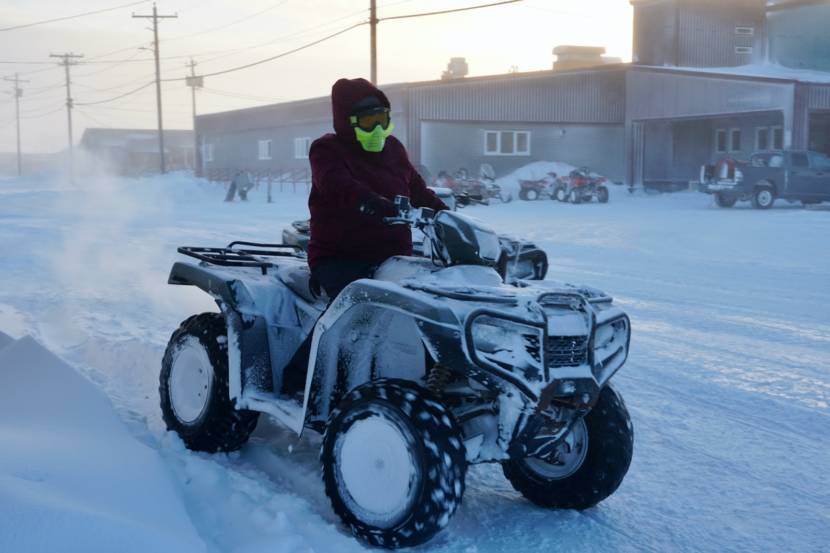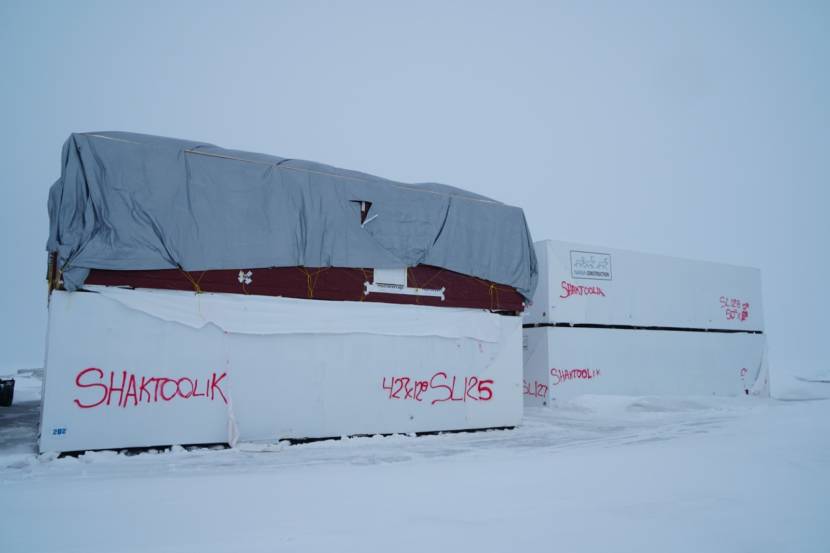
The smell of moose soup and the sounds of “Teenage Mutant Ninja Turtles” fill Sophia Katchatag’s small, two-bedroom home in the Norton Sound village of Shaktoolik. She and her husband share one room with their two younger children. Their two older kids share another room.
“I mean, I would love for me and my husband to have our own bed, but we just work with it,” she said.
Their teenage daughter wants her own room, too, but Katchatag said expanding isn’t financially feasible even with two incomes, especially with the recent spikes in lumber prices. She said she feels lucky to have her own place at all, which the family inherited in May and renovated with money from the region’s tribal housing authority. In the past, they shared a single bedroom in her mom’s house, living with extended family.
“To be honest it was hard, it was challenging,” she said. “Not having your own privacy, your own space and having to be on everyone’s schedule, do things on their time.”
Statewide, Alaskans are twice as likely to live in an overcrowded household than the national average. Rates are highest in small, off-the-road-system communities like Shaktoolik, where around 60% of residents live in overcrowded conditions. The federal Department of Housing and Urban Development defines overcrowded as more than one person to a room in the house, including the living room and kitchen, and severely overcrowded as more than 1.5 people to a room.

“To be honest, in some of our places, if you’re living in a house that only has 1.5 individuals per room, that’s not going to be one of the more overcrowded houses in your community,” said Brian Wilson, executive director of the Alaska Coalition on Housing and Homelessness.
The problem is perennial, but the COVID-19 pandemic has made living with it harder.
Cramped conditions offer little space to work from home, conduct virtual schooling or quarantine, and they put multigenerational households at increased risk of infection, especially in communities with limited access to water and sewer.
“You know if one person in that home contracts COVID-19, it is impossible to physically space out and prevent the spread of that,” Wilson said.
Thankfully, he said, the places in the state with the highest rates of overcrowding also have the highest rates of vaccination. And in Shaktoolik, the tribe used federal COVID relief funding to retrofit an old clinic as a quarantine house. But, he said, the risk is still high.
“These are primarily smaller communities where everybody knows everybody, and it’s a beautiful thing culturally to say that if I live in one of those communities and I see my uncle or my brother or my friend’s nephew in a houseless situation, that I take them in,” Wilson said. “Unfortunately, the byproduct of that is the severe overcrowding, which can also be a very dangerous.”
Not enough homes

Former Shaktoolik mayor and current Bering Straits Regional Housing Authority commissioner Eugene Asicksik said overcrowding leads to a host of problems in his community.
“You have too many adults living under one roof,” he said. “I think that adds to the social problems that occur when you have adults arguing or, you know, having a different opinion or fighting over the TV remote control and all that stuff.”
He’s been working to address housing issues in Shaktoolik for decades, and he does see some progress being made. But he said part of the problem is something that can’t be changed: Shaktoolik’s geography. The few vacant homes need work because of the harsh climate and substandard construction. And because the town is only accessible by barge or small plane, high construction costs keep people from building more or renovating.
“Everything has to be ordered,” Asicksik said. “One sheet of plywood can cost you over $100, $130 sometimes.”

Financing is difficult, too, because most of the land is owned by the village corporation instead of homeowners and bank loans are often inaccessible. Asicksik said he learned that personally, when he expanded his own home to make space for his children and grandchildren, and he had a hard time accessing a loan because he didn’t own the land. He had to put everything he owned up for collateral.
Climate change is also eroding buildable land and slowing down economic activities like crab fishing, which used to provide more jobs in the village.
And, Asicksik said, there’s a lack of awareness and resources to address the problem.
“I don’t think there’s much consideration to what goes on in the bush,” he said.
Roughly 250 people live in Shaktoolik, which is about 125 miles east of Nome. The community is around 97% Alaska Native.
The region’s federally funded tribal housing authority is responsible for the bulk of the town’s residential construction. They haven’t built here in more than a decade, but thanks in part to federal COVID relief funding, Shaktoolik is getting four new modular houses.
That’s welcome news for city clerk Isabelle Jackson. Like many other residents, she’d thought about leaving because of the high cost of living and lack of housing options. But the subsistence lifestyle and the tight-knit community have kept her here. She’s waited almost 10 years for a home of her own.
“I remember the moment when they called me, and after they said I’m one of the recipients for a three-bedroom home, I started crying. I got quiet. Tears rolled down my eyes, just for, you know, happiness,” Jackson said.

Jackson will pay an income-based rent for 25 years and then own the home outright. Right now, she and two of her kids share a hallway. Her father, who’s sick, sleeps on the couch. That’s been particularly difficult during the pandemic ,when they’ve worried about spreading the coronavirus.
“We’re, like, helping each other out, you know, taking care of him right now. But yeah, it’s difficult when my son wants to, you know, play and stuff, but he has to, you know, be quiet and have that respect,” she said.
Tackling a complex problem
Shaktoolik’s four new modular houses, including Jackson’s, are stacked in Nome’s shipyard until the barge can access Shaktoolik in the spring. They were pre-built in Big Lake by NANA Construction last summer, but weather delayed their arrival.

Jolene Lyon, CEO and President of the Bering Straits Regional Housing Authority, said that ideally they would have built them onsite to help create job opportunities for residents. But when the extra funding from the CARES Act and American Rescue Plan came in, they wanted to act fast.
“Our main objective is to get homes up and going in these communities. And in this instance, this was the fastest way to do it,” she said from her office in Nome. “Right now, COVID is frightening too many people. Being able to have your own space alleviates a lot of that mental stress.”
The tribal housing authority serves 17 villages in the Bering Straits region, which is the third most overcrowded region in the state. Lyon said building in such a diverse and remote region isn’t easy. From different soil types to harsh winter storms to permafrost, there’s no one-size-fits-all design.
“The challenges are not just in building a home, it’s designing a home that works for the environment in the community that you’re in,” Lyon said. “And so we ask the tribe as much information as to what they want, versus what we’ll be able to provide for that build.”
Normally, federal funding allows the housing authority to bring new homes to each village every decade, but the extra funding is helping them build more homes more quickly. In addition to the modular homes, they’re also bringing three new homes to the remote island of Diomede and four to Wales on the western tip of the Seward Peninsula.

Still, it’s only a small dent in the problem.
“We don’t have the funding,” Lyon said. “That makes it very difficult and frustrating sometimes, when you know that the need is greater than that. And you could deliver on doing more but it’s just that’s not the reality of it.”
And even if they did have the funding, income requirements and program guidelines keep some people in the region from accessing new homes.
Lyon said the region needs an estimated 400 new homes to meet the need and alleviate overcrowding. They’ll tackle the problem one home at a time.



